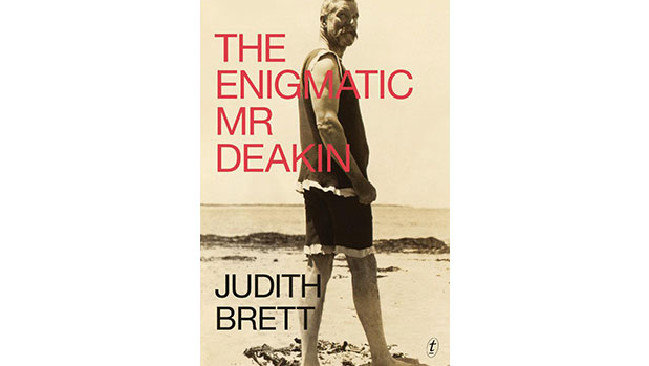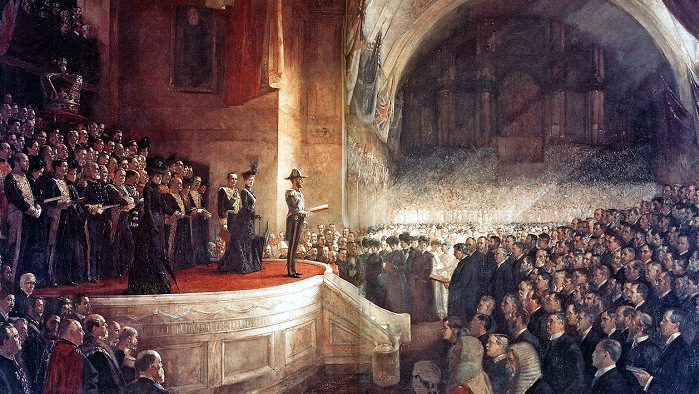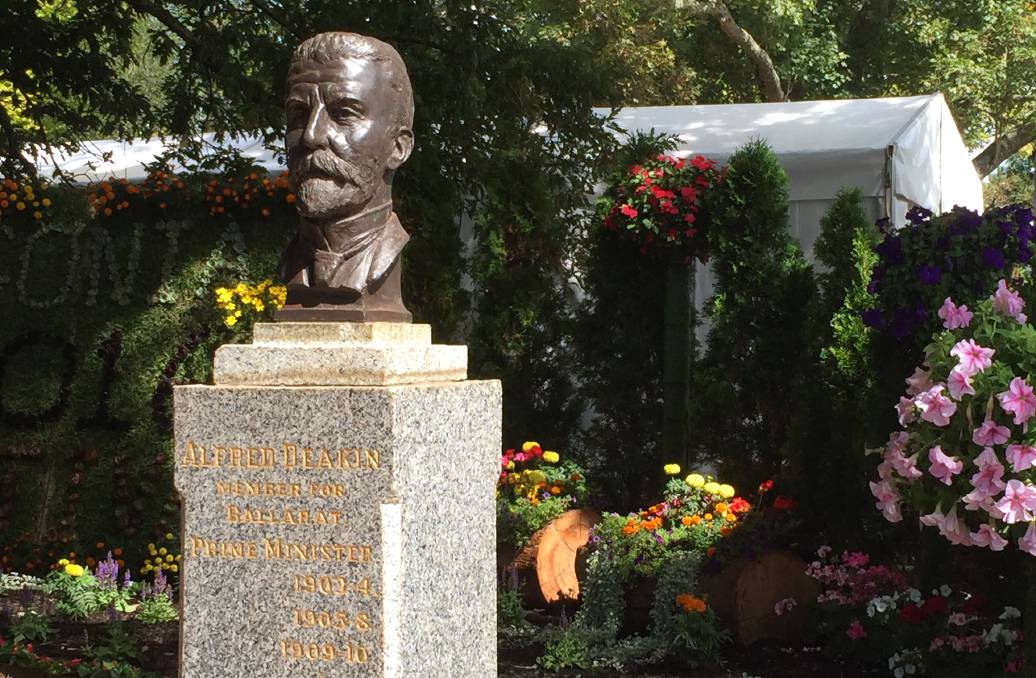Alfred Deakin (1856–1919) was born in Melbourne and became the second Prime Minister of the nascent republic in 1903. He served two other terms in the big chair. Earlier he had been elected to the Victorian parliament in 1879 at age twenty-two and became a cabinet minister in 1883 at twenty-seven. He was active in the colonial discussions of federation from the earliest days and travelled to England as a representative of Victoria in the continuation of those negotiations with the Crown. During his parliamentary career he represented Ballarat, which by chance we recently visited.

His parents immigrated to Adelaide from Old Blighty in 1850. His father was a travelling salesman who left little behind in England but his mother was a homegirl from Wales and missed the Old Country for years and years. When gold popped out of the ground in central Victoria, already in Adelaide, they joined the thousands who trooped there. His father had the wit to realise that luck more than anything else determined success in gold mining and turned to supplying the needs of miners by offering transportation to and from Melbourne for passengers, goods, and gold. As a career traveller he knew quite a bit about that. The family lived in Melbourne not Ballarat.
Deakin’s entry into politics came young, as a member of the parliament of the colony of Victoria in his twenties. That became the rest of his life. While as a youth and even when a young parliamentary he was interested in spiritualism, that wore away for more conventional religion. Spiritualism of one sort of another was a fashion in the latter part of the Nineteenth Century, and interest was later renewed by the horror of World War I.
Deakin married a social equal but not an intellectual one, and his wife was relegated to the most conventional role as wife and mother. She did not welcome the meet-and-greet that went with politics, and over the years few people visited the Deakin home.
Deakin saw a great future for Australia, freed from the historic conflicts of Europe, and was an early champion of continental unity of some kind. Into the late Nineteenth Century the separate colonies charged each other tariffs, and competed for precedence in London. They also had conflict over the waterways like the Murray River. The first move was to create a single market. As logical as it seems, it disadvantaged some vested interests and created divisions that remained in new configurations.
There were the Protectionists who dominated Victoria and the Free Traders in the ascendancy in New South Wales. Both types were strongly oriented to Great Britain. There were further divisions within each camp. Deakin emerged as the leader of the Liberal Protectionists in Victoria against conservatives who wanted to privilege property owners by not taxing them. Conservatives opposed legal protections against child labor, working hours, pensions, and the like. By and large Deakin favoured such measures.
He rocketed to the top of the Victoria politics before he was thirty. He liked an audience and was a good speaker, moreover, he was a disciplined and hard worker at the desk. He cut an impressive figure, spoke well, and advocated unity. His father had run a stage coach line between Ballarat and Melbourne and Deakin went to that constituency. Though we saw nothing special about him when we visited Ballarat but then we did not go looking for it. When he rose to the top he was one of the few native born Australians in the parliament and he played that card.
As minister of the crown in Victoria he spent freely with all that gold in them thar hills. Train lines were built and the bridges, culverts, embankments, stations, and switches to make them work. Even today some of these lines are only now being laid to rest, as one of our guides complained in 2017. Deakin never did seem to grasp the relationship of income and expenditure. His affinity with the Labor Party may have stemmed from that.
There were inter-colonial conferences about trade and commerce, e.g., the Murray River. The fiftieth anniversary of Queen Victoria’s ascension was unprecedented, and it led to a massive gathering in London that was the seed from which CHOGM grew via the Empire and the Commonwealth. Deakin was a hit there and liked the whirl, social and political. His prominence there made him a hero in Melbourne when he returned to the adulation these days accorded only to athletes and airheads. He advocated Australian unity with urgency because of renewed interest in the Pacific by the European colonial powers France and Germany. The French penal colony in New Caledonia was next door to Queensland. German incursion into Northern New Guinea was disconcerting. However England had no interest in provoking a European war over some specks in the Pacific Ocean.
While he never lost his British identify, Deakin concluded that Australia must unify to protect itself. Later when Japan became a British ally and England seemed content to let expand its influence in the Pacific, once again Deakin saw a fissure between the interests of England and Australians.
But first came federation. There were many meetings of representatives of the colonial governments in Melbourne, in Sydney, and in Adelaide, all made difficult by transportation. Not all colonial governments sent representatives to each meeting. West Australia, then as now, played hard to get. Queensland was sometimes embroiled in its own soup, though its conflicts with France over sugarcane slavery would drive it into federation, but first its North-South division would have to be papered over. This latter rupture recurs between FNQ and Brisbane, as the second largest city of New South Wales, as we were once told in Cairns.
New Zealand participated in some talks but quit the scene. Tasmania was included in Victoria during the deliberations. The vast interior that is the Northern Territory had no agent.
Though federation was the logical step, the sitting colonial premiers could never quite be satisfied of the terms. It was a John Quick who proposed taking the final decision out of the hands of incumbents with a referendum. That broke the log jam. The fine-tuning led to the supermarket combination of political institutions taken from Westminster and Washington. The smaller states wanted protection from the larger states and that was the role of the Senate. Proportional representation and the preferential ballot evolved from the hostility and distrust of the anti-federationist who feared a large and remote government. This mutual distrust meant that a national capital was stymied in Deakin’s time. It could not be in any state capital for fear that it would be captured by its environment.
As federation came to prevail, the agreement, partly unspoken, was that the first prime minister should come from the Mother Colony from which the others came, namely New South Wales, and George Reid, the premier of NSW was a keen federationist. When the Colonial Office and the Foreign Office in London finally made peace with each other and Australian federation proceeded the plan was to create a whole, single colony and its first Governor-General would be John Hope, Earl of Hopetoun who would then appoint the first prime minister and cabinet, which in turn would superintend the first national election three months later from which a government with the consent of the governed would emerge.
Ah huh. Meanwhile an election was held in NSW. There were not yet coherent political parties by any manner or measure. Parliamentary groups were loose agglomerations around prominent individuals with little or no binding ideology or loyalty. Those in NSW who opposed federation did so because they advocated free trade and feared the dominance of gold-wealthy Victorian protectionists briefly united to undermine Reid.
Peter Lyne had became NSW premier. In these pages he is characterised as a local fixer with no wider horizon. If anything, he opposed federation, though such abstractions were of little interest to him. There were many hasty meetings and much telegraph traffic among supporters of federation to find another way that would avoid Lyne, who as the first Prime Minister might block federation.
The Governor-General felt duty-bound by the agreement to appoint the premier of NSW at the time as the first prime minister and so he asked Lyne to form a government. Deakin and other leading federations schemed to scupper the exercise. Deakin’s profile throughout Australia and in London was so high that a government without him would lack credibility. Yet he could not directly refuse because that would allow personal opponents and enemies of federation to paint him as selfish. Much squirming follows. In such situations Deakin prayed, wrote in his copious diary, schemed, threatened to leave politics, and such, as time passed. But as long as he did not commit to joining a Lyne cabinet, then others held out, too. He said neither yes nor no.
 Federation
Federation
Lyne was under pressure to form a government quickly to organise elections by the three-month deadline and he just could not do that, and he was not greatly motivated to do so anyway, as he was more interested in pork-barreling in NSW, so he conceded defeat. That freed the Governor-General who turned to Edmund Barton of NSW, an arch federationists who collaborated with Deakin. Barton was not a premier but he was from NSW.
It is all confusing because Barton in NSW was a rarity, a Protectionist, but also a federationist. The election was held and Barton had enough support to continue in office, but support was personal and varied from issue to issue in the absence of parties. What galvanised the advent of parties was the entry of Labor representatives, led by Chris Watson, whose members foreswore individual initiative to comply with the line of the whole, i.e., the party line. Such cohesion and surrender of individual conscience repelled Deakin (and others) but he had good personal relations with Watson and they agreed on much.
While Deakin was ready always to legislate paternalist measures to enhance the status and lives of workers under the protectionist umbrella, he was uneasy with their ambition to take part in governmental directly. While they agreed on much legislation, Deakin could never quite accept Labor, though his governments depended on the votes of this bloc.
 Deakin from the parade of Prime Ministers in the Ballarat Botanical Gardens.
Deakin from the parade of Prime Ministers in the Ballarat Botanical Gardens.
A succession of governments prior to World War I came and went, each based on personal followings and informal coalitions. While Deakin depended on and got support from Labor MPs he did not want a formal alliance with the ALP. It is a little like the Red and Blue governments in Canada of Arthur Meighen when Conservatives and Socialists combined against the Liberals of Ontario.
Deakin succeeded Barton in one such turn of the wheel, and then he stood aside when key legislation failed and there came the first Labor government with Chris Watson as prime minister for a few months. He was followed by Reid, the NSW federationists Free Trader, who had a turn, and then Deakin, then another Labor government of Andrew Fisher, and then again Deakin. The rise and fall of governments between 1901 and 1914 was largely done in parliament since election results in 1903, 1906, 1910, and 1913 did not produce disciplined majorities.
Through these years, Deakin saw himself as creating Australia, not serving the regional interest of Victoria, or any sectional class interest. Measures that did that he always opposed, including some put forth by Labor.
Hindsight allows a contemporary reader to see the emergence of a consensus behind protectionism with an accommodation from Labor. The Great Tariff Wall of Australia that resulted only wobbled in the 1980s, when another kind of Labor government saw it as a liability in the world of the time. Hindsight also shows the deep divide between the colonies become states, and the divisions within Queensland. These remain.
The Pacific environment fuelled unity and federation. When England proved disinclined to go to war over French, German, and Japanese influences in the region, Australians united. While West Australia was bellicose about its uniqueness and independence and Queenslanders concentrated on arguing with each other about whether it was to be one state or two, when a Japanese fleet set sail, they all rushed to embrace the Australian flag.
The arrangement with England that Deakin negotiated was for Australians to raise funds, through taxes, to pay a subvention for Royal Navy operations in Australian waters. Whether this arrangement was unique, I cannot say, but New Zealand must also have had an interest in such protection. I also wondered about the Canadian west.
Deakin’s career went on but his health failed, mainly his mental health, and he wisely chose to quit politics though there were no generous pension provisions at the time. His memory and mind were no longer as sharp as once, yet he still cut an imposing figure. When World War I came he was conspicuously silent largely because of his mental frailties, but since he looked fit, Faux News of the day criticised hm for a lack manly bloodthirstiness.
As his role decreased his wife Patty’s grew. She began to take part in ceremonial activities and then became a champion in war work, raising money, interceding for returned, wounded, and maimed soldiers, and Deakin’s role become one of supporting her. She and Deakin’s sister had been at odds throughout their lives. There had many tensions and eruptions, but in these latter years Patty came into her own.
Although the book opens with an intriguing parallel between Deakin and the infamous outlaw Ned Kelly, it has nothing to say about the Eureka Stockade of 1854 and any influence that might have had on Deakin. That silence is noteworthy given how strident the Museum of Australian Democracy at Eureka is that Australian democracy was founded in that event. Deakin seems to have missed this point. Elsewhere on the blog I have commented on this museum.
The book is impressive for its extensive research, considered insights into the man and the times, its careful judgements, and the ease with which the story unfolds. The author resists the temptation that afflicts so many writers to inject herself, her attitudes, her sensitivities, her opinions into the story from another world. Deakin is taken on his own terms and on the terms that prevailed in his time and place, and presented fully in a way that allows readers to draw their own conclusions. Once such an approach was the norm, not it is the exception.
Deakin always kept a diary, he sent and received letters by the score and kept just about every piece of paper it seems. This trove gives the biographer rich pickings which are judiciously employed, though after a time this reader grew weary of another meeting, another diary entry, another pondering of the imponderable.
 Judith Brett
Judith Brett
The cool distance taken by the author from the subject is in contrast say to the book I read about the women of the Eureka Stockade in which the author lectures the reader about what to think and why step-by-step. Whoever devised that term ‘public intellectual’ should be, per ‘Clockwork Orange,’ strapped down and made to watch and listen to batteries of such self-styled PIs babbling. Regrettably I have had to hear far too much from far too many of these clowns, while dreaming of such punishment. The hallmark of a Public Intellectual is a combination of opinion and volume, i.e., shouting nostrums unencumbered by facts, reason, or logic.
Skip to content
